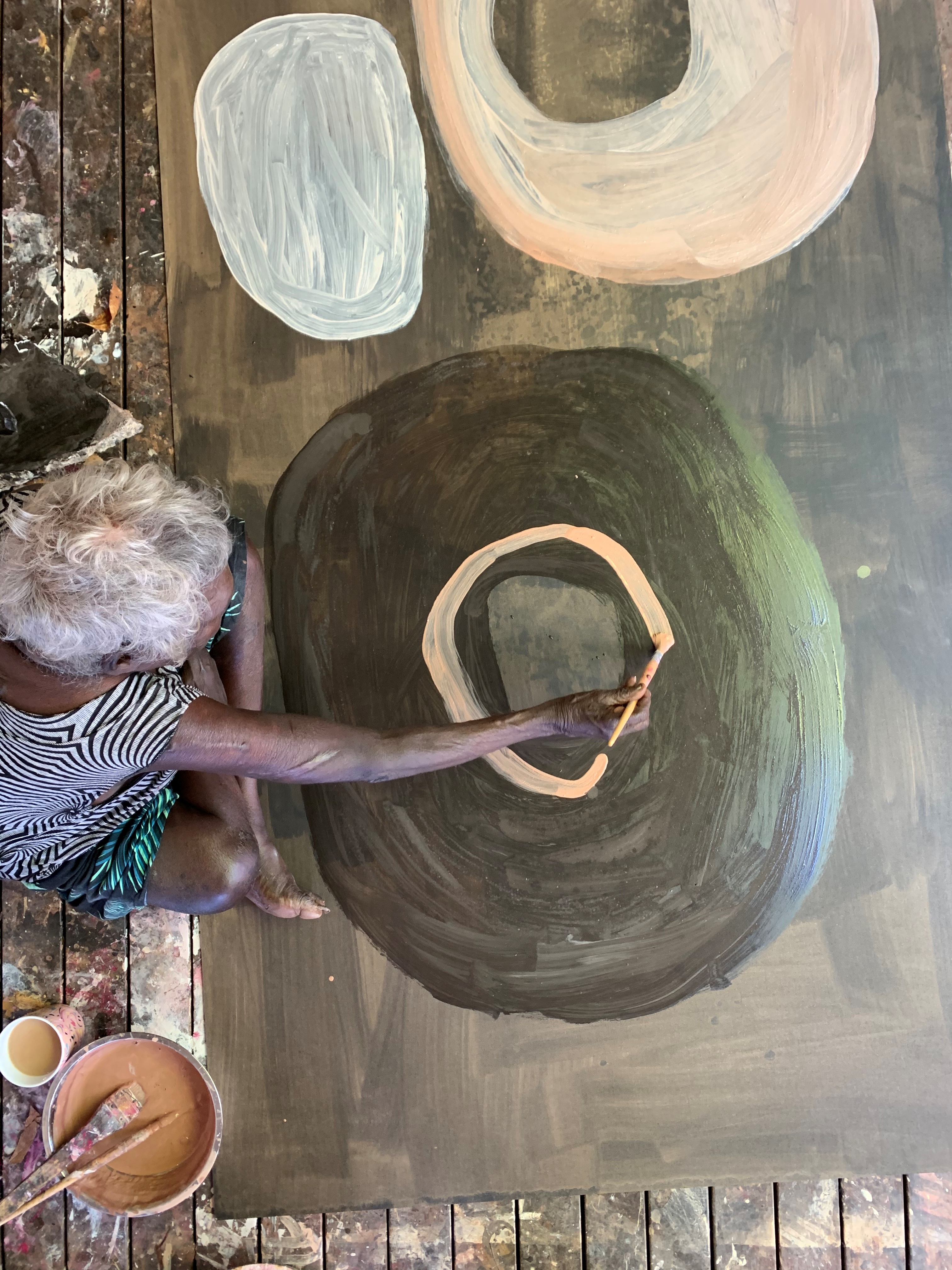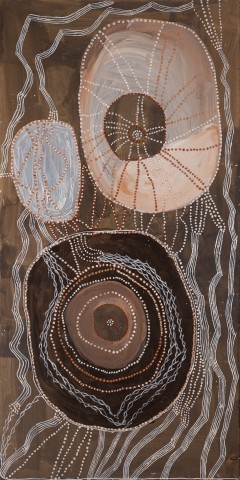BARATJALA, 2020
NOŊGIRRŊA MARAWILI
natural earth pigments and printer ink on composition board
242.0 x 121.5 cm
bears inscription verso: Buku–Larrŋgay Mulka Arts cat. 2301-20
Buku–Larrŋgay Mulka Centre, Yirrkala, Northern Territory (label attached verso)
Alcaston Gallery, Melbourne
Private collection, Sydney
This work is accompanied by a certificate of authenticity from Buku–Larrŋgay Mulka Centre.
Deutscher and Hackett would like to thank Will Stubbs from Buku-Larrŋgay Mulka Centre for his assistance in cataloguing this work.
230045 (2).jpg

Noŋgirrŋa Marawili’s imposing contemporary bark painting Baratjala, 2020, crackles with energy. Bouncing between circular rock forms, Noŋgirrŋa’s fluid gestures evolve from jagged parallel lines into regular dotted chains and loose strings of diamonds and back again. Evoking the rhythm and cyclical interactions between extreme currents, tides and breaking waves of her maritime lands, these lines are Noŋgirrŋa’s own stylistic invention, adapted from the hatching and cross-hatching of her father’s and family’s miny’tji (sacred clan designs). Noŋgirrŋa has capitalised on a gender specific way of working within the confines of Yolŋu law while asserting a responsibility for, and belonging to, country.
Painted in deep hues of burnt umber and ochre, starkly contrasted with overlaid lines of white gypsum, the tones of this work signal Noŋgirrŋa’s return to the natural pigments of Yolŋu art after a period of experimentation with bright synthetic inks from printer cartridges in 2017 – 2018. For Yolŋu, it is customary to paint country using only materials collected from country. The muted shimmering tones of Baratjala creates a warm and melancholic effect. This mirrors the role of senior women in ceremonial song cycles, who instead of singing, perform the milkarri (crying songs) as explained by the artist’s brother, Djambawa Marawili AM, ‘her paintings cry for the land’.1
Noŋgirrŋa’s father was Yolŋu leader Mundukul Marawili of the Madarrpa clan and her mother, Buluŋguwuy, was one of four wives. Her childhood was spent in a large, extended family group, living wakir (nomadically) around Yilpara and Blue Mud Bay, using a flotilla of hand-hewn canoes to travel between Groote Eyelandt and the mainland. While Noŋgirrŋa started painting in the early 1990s assisting her husband, Djutatdjuta Munuŋgurr from the Djapu clan, it wasn’t until after his death that she would become a regular painter at Buku-Larrŋgay Mulka Centre in Yirrkala, and began to paint the lands of her paternal inheritance.2 Her current work refers back to these areas, remembering ancient ways of living directly on country as she had done as a child.
A leader in the innovation of contemporary bark painting, Noŋgirrŋa has pushed the boundaries of what Yolŋu law permits in its art practice. She uses sophisticated gestural abstraction to respectfully disavow any sacred intent, while keeping a personal foundation to its artistic vocabulary. The qualities of her expressive abstraction have enabled public institutions such as the National Gallery of Australia and the Art Gallery of New South Wales to recently reposition her work adjacent to (and in discussion with) artworks by Tony Tuckson and Rosalie Gascoigne in their permanent collection galleries. Her technical innovations, including use of printer cartridge ink and composition boards such as featured in Baratjala, bypass the seasonal limitations to the harvest and preparation of stringybark wood, allowing her to continue producing artworks all year round. Her creative interpretation of the rules has both carved out as space for her own practice and broadened Yolŋu and external understanding of what bark painting can be in the contemporary world.
The visual power of Noŋgirrŋa’s work and its innovation within cultural laws have not gone unnoticed in the Western structures of the art world. After winning Best Bark in both 2015 and 2019 NAATSIA awards, Noŋgirrŋa’s work has been the subject of a major solo exhibition at the Art Gallery of New South Wales (2018), as well as included in major group exhibitions, such as Tarnathi, Art Gallery of South Australia (2019); NIRIN, Biennale of Sydney (2020); Know My Name, National Gallery of Australia; and Bark Ladies, National Gallery of Victoria (2021 – 2022).
1. Djambawa Marawili, 2015, quoted in Pinchbeck, C. (ed.), Noŋgirrŋa Marawili. From My Heart and Mind, Art Gallery of New South Wales, Sydney, 2018, p. 44
2. Noŋgirrŋa had already referred to Madarrpa subject matter in a tentative manner through printmaking – the Yirrkala Print Space at Buku-Larrŋgay Mulka Centre existing since 1995, with elders limiting the use of sacred designs to works created completely manually, using natural materials. Ibid, pp. 15 – 16
LUCIE REEVES-SMITH
